Text
INTESTINOLOGY Series 3: With DIAMONDS You Repay I Don’t Care For Heaven
I explore society’s obsession with consumer culture. Advertising images often aim to disempower and objectify the consumer. They promise that a product will make the consumer happy and enhance their quality of life. It is as if owning these products will bring the consumer closer to a more complete and happy state of being. The packaging of these products—their colour, endorsement by celebrities, and alignment with popular identities—are designed to make them appear more attractive. But there is another thing thatcan make a product appear more attractive; a non-physical intensifier (such as a ritual), which can give the process of consuming a product a mythical and even spiritual dimension. The work is a development of my INTESTINOLOGY series, which investigates how everyday objects like can take on a life of their own. The series explores how a change of context can ‘redigest’ an object originally used for a criminal purpose and transform it into an innocent and pleasant one. In the work, I explore this idea through tomato ketchup, a popular condiment that is frequently used to represent blood in film and theatre productions. In 1963, a bottle of tomato ketchup containing the fingerprints of English thief Ronnie Biggs became a key form of evidence during his trial for his role in the Great Train Robbery. The bottle is now displayed in the Black Museum, a collection of criminal memorabilia held at the headquarters of the Metropolitan Police Service in London. The way the ketchup was displayed asa criminal artefact made it seem as if it were condemned, sullied by the handsof its user. The work combines a PVC pop-up display with videos and objects that appear to advertise tomato ketchup. One of the videos, DIRTY deed KETCHUP done DIRT cheap, is an MTV-style video, whose music is based on the song ‘Bad Girl’ by Hong Kong singer and actress Anita Mui. In the video, the main character—dressed as Anton Lavey, the occult leader and founder of the Church of Satan—communicates that consuming ketchup as a ritual will make us happy. The pause (the moment in an advertisement when an actor deliberately holds the featured product in full view) and the work’s liturgic feel aim to increase the viewer’s desire for the ketchup, which in the video becomes an almost sacred object.
-Joo Choon Lin
0 notes
Photo


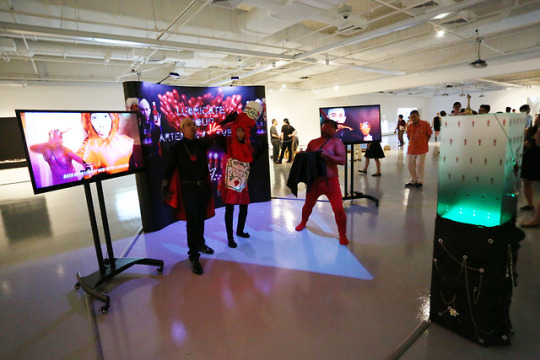

http://www.joochoonlin.com/index.php?/on-going-projec/-with-diamonds-you-repay-i-dont-care-for-heaven-/
0 notes
Photo
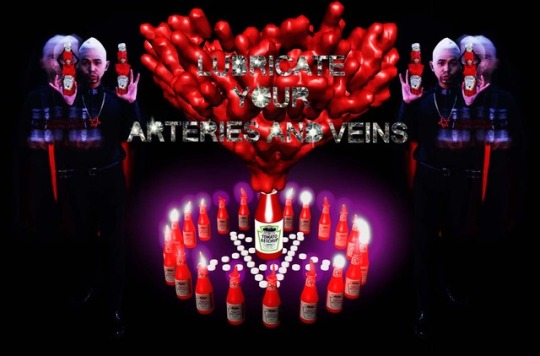
† INTESTINOLOGY Series #03: With DIAMONDS You Repay I Dont Care For Heaven † Multimedia Installation †
0 notes
Text
TEXT
By Julien Zerbone
Joo Choon Lin
The Black Paraphernalia
Do objects lie, asks Joo Choon Lin, or are they the victims of our lies, of our ulterior motives, of the evil which lives in us? There is this book which I have brought with me, Black Museum, written by Jonathan Goodman and Bill Waddell, which refers to the museum of the same name, created in the late 19th century by an inspector working at Scotland Yard, who had collected a large number of objects at crime scenes, with the purpose of teaching new recruits how to detect and prevent crimes. More than 500 souvenirs are kept in it, hidden from the public eye, ranging from letters attributed to Jack the Ripper to fake banknotes made by Charles Black, one of the most famous forgers in modern history, by way of a bottle of ketchup, which was present at the Great Train Robbery. These objects are the involuntary accomplices to the infamy of their users, and at times their creations. In this museum, they are doomed to eternal damnation, without one day being able to wash away the guilt which weighs over them. But are they bad by nature? In the manner of Edgar Allan Poe’s short story The Purloined Letter, our relation to the world is established under the seal of suspicion, like detectives, we look for the early warning signs of an imminent tragedy. So the kitchen knife and the kitchen glove become fetishes, the avatars of the murderer, of persons wishing to protect their anonymity, in a world where everything ends up being like a murder, where suspicion is ever present.
Fetishes
Our conception of fetishism stems from the contrast, peculiar to the humanist ideology, between the “human person” and the “thing”, which prompted Marx to consider that fetishism consists in—wrongly—perceiving social relations in the form of relations between objects, in “marketing” human relations, implying that there are relations which are purely human and not mediatized. In so doing—like Michael Fried when, in his famous essay, he talks about the objecthood of Anthony Caro’s sculpture--, we confuse the formal, “immediate”, phenomenological property of the fetish object and the status, the aura which is conferred upon it within the social structure. Where fetish is concerned there is just faitiche,9 to use Bruno Latour’s fortuitous expression, Joo Choon Lin tosses at me, the fact that currency makes it possible to have access to objects in the market does not have to do with its own properties, just as the fear inspired by the kitchen knife is only indirectly the fact of its physical characteristics, but rather of a set of socio-symbolic relations in which they are caught, and which gives them the ambiguous capacity of speaking for us, of acting for us, of making puppets of us: thus the murderer who, caught in the act, lets go of his weapon as if he was previously possessed, and thus the masks that we wear during carnivals.
Intestinology
I want to build a monument, a retable, an altar to the glory of the objects of this world, to everything we have, through our conduct and by way of our creations made “objects”. The cow is first of all considered for the milk and the meat that it provides, wheat has no reason for being other than providing the matter necessary for flour: the whole world, Joo Choon Lin explains, has been reconfigured, reality is now modelled in accordance with man’s needs, the objects and beings which surround him are judged and identified on the basis of their usefulness, discarded, abandoned, erased from our memories when they are no longer useable. Intestinology will be the name of this new approach, this cult, this discipline. Like an intestine, we will have to learn how to digest anew the world, testing it in our very flesh, trying to separate the wheat from the chaff. The intestine is thought of as dirty and impure, and yet the porousness of its membrane enables it to separate nutriments from toxic substances, and find in the world what is not only useful to us, but vital. Similarly, depending on the fate earmarked for it, the kitchen knife can become an instrument of death or a tool for life. This is not the case for this organ which may, on the face of it, be good or bad, it is the very organ of experimentation. The diamond will be its symbol, its paradoxical emblem: its whiteness, its transparency, and its hardness make it a paragon of purity and wealth, the object of all our desires; and yet is it not made of the same matter as coal, which, on the contrary, incarnates impurity, dirtiness, the suffering of miners, and the death which people inhale? We, humans, are endlessly separating good from evil, we are forever blaming the world which surrounds us for what resides in us. Intestinology, on the contrary, establishes fluid continuities, highlights forms of solidarity and continuity, precisely where we set up boundaries and differences of natures.
0 notes
Photo

0 notes
Photo
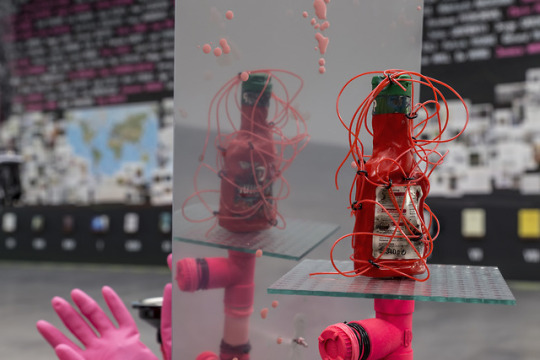
INTESTINOLOGY SERIES: The Black Paraphernalia † Hanging Installation † FRAC † Nantes, France † 2015
† Medium: Household knives, Gloves, Shower curtain, Eyelets, PVC cloths, PVC Pipes, Basin waste stopper, Ropes, Chains, Belts,
Safety Pins, Synthetic resin and Garbage bags †
0 notes
Photo

Great Train Robber Ronnie Biggs
The Ketchup bottle - pictured with an arrow pointing to Biggs' fingerprint - has been shown along with other crucial pieces of evidence found by police who were investigating the crime of the century .
0 notes
Photo
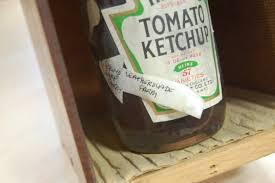
Great Train Robbery: ketchup bottle that snared Ronnie Biggs
Ketchup Bottle kept in Scotland Yard's Black Museum
0 notes
Text
†INTESTINOLOGY† Series #02: The Black Paraphernalia † Hanging Installation † FRAC † Nantes, France † 2015
†Medium: Household knives, Gloves, Shower curtain, Eyelets, PVC cloths, PVC Pipes, Basin waste stopper, Ropes, Chains, Belts, Safety Pins, Synthetic resin and Garbage bags†
The works draw inspiration from the Black Museum in Scotland; it is a collection of criminal memorabilia kept at the New Scotland Yard. I am investigating how certain objects can affect a material echo which creates fear in people. How are they able to withhold retentions from the past, so to communicate to future events and actions? How is remembrance precipitated in objects?
There are many objects in this world that would seem a perfect fit to a crime scene. A pair of gloves, a rope or a knife has become the essential props used in horror films. I set out to liberate these objects of their ‘evil’ reputations and through my self-established philosophy of art-making, termed as Intestinology, to ‘redigest’ them with a more pleasant intonation
However, to what extent can we change the fate of an object? Similar to our digestion system, there are things that our bodies can never break down. For example, we can mostly digest food and if we were to swallow a metal screw, it will probably make it through our digestive system as one piece. Certain objects are universally recognised as symbols of evilness, deeply imprinted in our subconscious. They are scarcely able to escape their own destiny; even after ‘defecation’, they still reeked of their filthy origin.
Objects are condemned to such a tragedy, as they are habitually ill-used by human beings. A knife is stained with blood when it is used to slaughter a cow for our food consumption. With good intentions, a kitchen knife can also be a common tool that helps us in our daily activities. When an object lands in the hands of a murderer, sullied by blood, it would then be forever convicted and remembered as an object of sin.
The Black Museum exhibited the belongings of criminals, found on them, when they were being apprehended. For example, even if it was a mere bottle of ketchup recovered from the infamous The Great Train Robbery. By displaying such objects, the criminal accounts are resurrected in the museum. Hence, a bland bottle of ketchup becomes condemned, even if it just faintly traces the representation of its felonious owner. Some of these exhibits could continue to upset or traumatize surviving relatives of victims. On the contrary, the objects in turn become a grieving mediation for the relatives of the perpetrators.
The work in this exhibition is about commemoration, like a wreath for condemned objects. I have made sculptures and installation using objects that is closely associated to crime paraphernalia or horror films. Perhaps, it is in the eye of the beholder, to venture into other forms of perception, granting these condemned objects a passage to a new lease of life.
0 notes
Photo


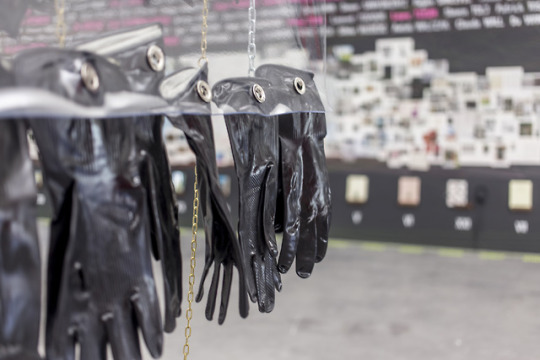


INTESTINOLOGY Series #02: The Black Paraphernalia † Hanging Installation † FRAC † Nantes, France † 2015
0 notes
Photo

The Black Paraphernalia † Hanging Installation † FRAC † Nantes, France † 2015
0 notes
Photo


† INTESTINOLOGY Series #01: We Have The Most Beautiful Intestine † 01:48 Min † 3D Modelling Video With Sound †
0 notes
Photo

Swedish Teen Sentenced After Incriminating Pre-Robbery Selfie
0 notes
Photo
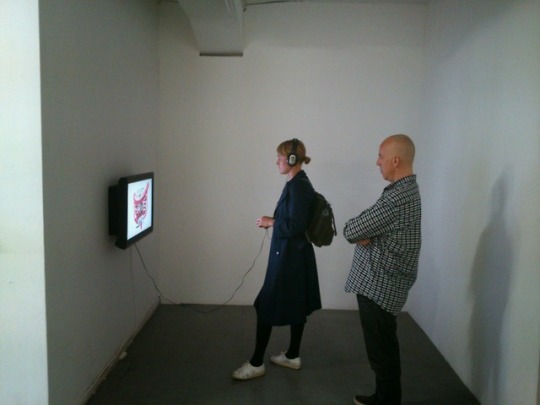
Skånes Konstförening | Malmö, Sweden
INTESTINOLOGY Series #01:
We Have The Most Beautiful Intestine † 01:48 Min † 3D Modelling Video With Sound
#Joo Choon Lin#INTESTINOLOGY#Digestion Machine & Underbelly#We Have The Most Beautiful Intestine#Skånes Konstförening#sweden
0 notes
Video
vimeo
0 notes